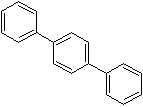p-TERPHENYL
PRODUCT IDENTIFICATION
92-94-4

TOXICITY
SMILES
C1=CC=C(C=C1)C2=CC=C(C=C2)C3=CC=CC=C3
CLASSIFICATION
EXTRA NOTES
Other RN:75831-65-1, 94363-13-0
PHYSICAL AND CHEMICAL PROPERTIES
REFRACTIVE INDEX
Stable under ordinary conditions.
EXTERNAL LINKS & GENERAL DESCRIPTION
USA.gov - p-Terphenyl
Wikipedia Linking - Terphenyl
Google Scholar Search - p-Terphenyl
U.S. National Library of Medicine - p-Terphenyl
PubChem Compound Summary - p-Terphenyl
KEGG (Kyoto Encyclopedia of Genes and Genomes) - p-Terphenyl
ChEBI (http://www.ebi.ac.uk/chebi/) - p-Terphenyl
NCBI (http://www.ncbi.nlm.nih.gov/) - p-Terphenyl
EPA - Substance Registry Services - p-Terphenyl
Local:
Terphenyl is an aromatic hydrocarbon consisting of three benzene rings connected to each other in either ortho, meta or para positions without any additional functionalization. This structure does not allow the fusion of benzene ring. Terphenyl structure is therefore not very reactive. Though pure terphenyl is a white crystalline solid, commercial grades are light yellow waxy-like flakes at room temperature, with a faint, pleasant odour. It is insoluble in water. Commercial mixture grade consists of generally o-terphenyl 2-10%, m- 45-49%, p- 25-35% and higher polyphenyls 2 to 18% with trace amounts of bidiphenyl.
|
Product |
o-Terphenyl |
m-Terphenyl |
p-Terphenyl |
|
CAS RN |
84-15-1 |
92-06-8 |
92-94-4 |
|
Melting point |
56.2 C |
87.5 C |
212.7 C |
|
Boiling point |
332 C |
365 C |
376 C |
Terphenyl is used as a preservative to prevent the growth of molds and fungus in combination with other antioxidants. Terphenyl is a starting material for the production of polychlorinated terphenyls, which are once used industrially as heat storage and transfer agents. Terphenyl is also used as an intermediate for the production of target organic compounds such as non-spreading lubricants, emulsifiers, optical brighteners, crop protection products, and plastics. m-Terphenyl is used in thermal printing material and as a coolant in nuclear reactors, and p-terphenyl as a laser dye and a sunscreen lotion component. It is used as a particle of radiation detector which operates through emission of light flashes (the emission maximum at 343 nm, lower maxima at 325 and 327 nm) that are detected by a photosensitive device. Some terphenyl derivatives are under study for useful as a pharmaceutical ingredient such as immunosuppressive, antiinflammatory and antitumor agents. Fluorine-substituted terphenyls are used as a component of liquid crystalline for high voltage holding ratio, low threshold voltage, and broad temperature range layers applications.
|
|
APPEARANCE
PURITY
99.0% min
MELTING POINT
210 ~ 214 C
HAZARD OVERVIEW
GHS (Globally Harmonised System) Classification: Skin irritation. Eye irritation. Specific target organ toxicity - single exposure. Acute aquatic toxicity. Hazard statements: Causes skin irritation. Causes serious eye irritation. May cause respiratory irritation. Very toxic to aquatic life.
GHS
Warning
PICTOGRAMS


HAZARD STATEMENTS
H315-H319-H335-H400
P STATEMENTS
P280-P305 + P351 + P338-P310
![]()
![]()
RISK PHRASES
36/37/38-50/53
SAFETY PHRASES
26-60-61